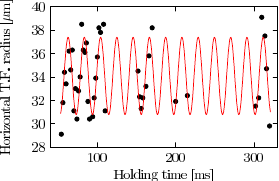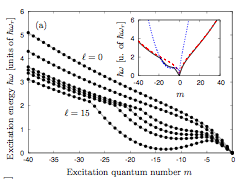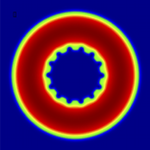Home Rubidium BEC project
Bose-Einstein condensation of dilute atomic gases is the subject of intense
studies since its first demonstration in 1995. Our group is expert in
manipulating atoms in radiofrequency dressed potentials.
In the past years we have focused on testing the superfluidity of degenerate Bose gases in a toroidal trap. Superfluidity and Bose-Einstein condensation occur at the same time in 3D weakly interacting Bose gases, but are of fundamentally different nature in reduced dimensions (1D, 2D). Our ring trap allows to study rotating superfluids in lower dimensions. See the SuperRing project page.
We are currently investigating the superfluid dynamics on a curved surface. In particular we are interested in the interplay between curvature and rotation. We have already demonstrated that our shell-shaped trap enables the study of supersonic flow. We will start soon a new project aiming at studying superfluid turbulence in this geometry.
- Recent results -
Supersonic rotation of a superfluid: a long-lived dynamical ring
We rotate at high speed atom at the bottom of an anharmonic "bubble" trap. The atoms reach a high angular momentum state in which they rotate at more than 18 times the speed of sound. Superfluid collective modes are still present in this out of equilibrium state.

Dynamical ring formed by fast rotation |

Resonance frequency of the quadrupole mode of the dynamical ring |
Superfluidity of a two-dimensional quantum gas probed by its dynamics
By recording the frequency of the scissors collective oscillation at several locations within a 2D trapped Bose gas, we have evidenced the regions where the gas is superfluid (close to the center) or normal (towards the edges), based on a pure dynamical criterion.

Principle of the measurement: the scissors oscillation is excited, and its frequency is measured locally, around a thin annulus of mean radius ra. |

Oscillation frequency of the scissors mode measured as a function of the radius: the superfluid phase is located at the center of the cloud (left), while the normal phase is evidenced at the periphery (right) with a different oscillation frequency. |
A two-dimensional quantum gas in a magnetic trap
We have confined quantum degenerate atoms to two dimensions in a trap relying only on static or rf magnetic fields. The trap is extremely smooth, well suited for the study of the collective modes of the quantum gas. We have observed the monopole, quadrupole and scissors modes in this trap. With a principal component analysis, we have recovered the first excitations of the Bogolubov spectrum.

Anisotropic time-of-flight expansion of the two-dimensional quantum gas. |

Monopole mode. |

first Bogolubov modes: dipoles, scissors, quadrupole-like and monopole-like. |
Analysis of the excitation spectrum of a superfluid in a ring trap
We computed numerically the excitation spectrum of a superfluid in a ring trap, with or without initial circulation. We found that the spectrum can be well understood in terms of surface modes, propagating either at the outer or at the inner edge of the gas. We predict the value of the critical superfluid velocity, as well as the maximum circulation that the gas can sustained in a given ring trap.

Excitation spectrum for various circulations l. |

Inner surface mode. |

Outer surface mode. |
A new setup for a fast production of BEC
 Fig. 1 |
Our new apparatus is made of three vacuum chambers connected by high impedance differential pumping tubes. The rubidium source is a 2D+-MOT, feeding a 3D MOT in the octogonal chamber (see Fig. 1) where the lifetime is already quite good (30 s). The atoms are finally transported mechanically in a quadrupole trap moving on a track, and cooled further to condensation in the science cell. There, the vacuum-limited lifetime reaches 140 s. See also details on our frequency doubled 2W laser source at 780 nm.
Left: a sketch of the experimental setup. |
Rubidium BEC produced in a plugged quadrupole trap
 Fig. 2 |
We produce a pure Rb BEC with 2.105 atoms after 20 s of RF evaporation in a quadrupole trap plugged with a 532 nm laser beam focused on 40 micrometers (Fig. 2). At first, the evaporation takes place in the linear (quadrupole) trap. Below 100 µK, the laser beam is essential against Majorana losses, largest at lower temperature in a pure quadrupole trap. At very low temperatures, the plugged trap is harmonic, and its oscillation frequencies are measured by resonant excitation.
Left: a Rb BEC produced in a plugged quadrupole trap, imaged after a 25 ms time of flight (TOF). |
Quantum gases in low dimensions
 Fig. 3 |
We have demonstrated the confinement of ultra cold atoms in a very anisotropic trap with oscillation frequencies wz >> wx, wy. The atoms first condensed in a quadrupole plugged by a blue detuned laser to prevent Majorana losses. They are then dressed with a radio-frequency (RF) field to be confined to an iso-magnetic surface of the quadrupole. As the laser is slowly switched off, the BEC follows the trapping surface to its bottom. The vertical oscillation frequency, due to the RF field, is then much larger than the horizontal ones, only due to gravity (pendulum frequencies), which is visible on Fig. 3 where the cloud after TOP has become very anisotropic. Left: TOF image of a BEC in a dressed quadrupole trap. |
Superfluid rotating in a ring geometry
The combination of the dressed bubble-shaped trap with a vertical standing light wave gives rise to a ring trap, as we recently proposed. We also proposed theoretically a technique to rotate the trapped atoms, which opens the way to experiments on superfluidity in a circular geometry. Adding the standing wave will be the next step in our experiment.
Quantum anomaly
In a recent theoric work, we studied the effect of a quantum anomaly on a Bose gas confined to 2 dimensions. The anomaly produces a small shift of the frequency of the breathing mode. We proposed a way to observe this effect in an experiment. See our poster.
Join us!
The BEC group is a member of IFRAF.